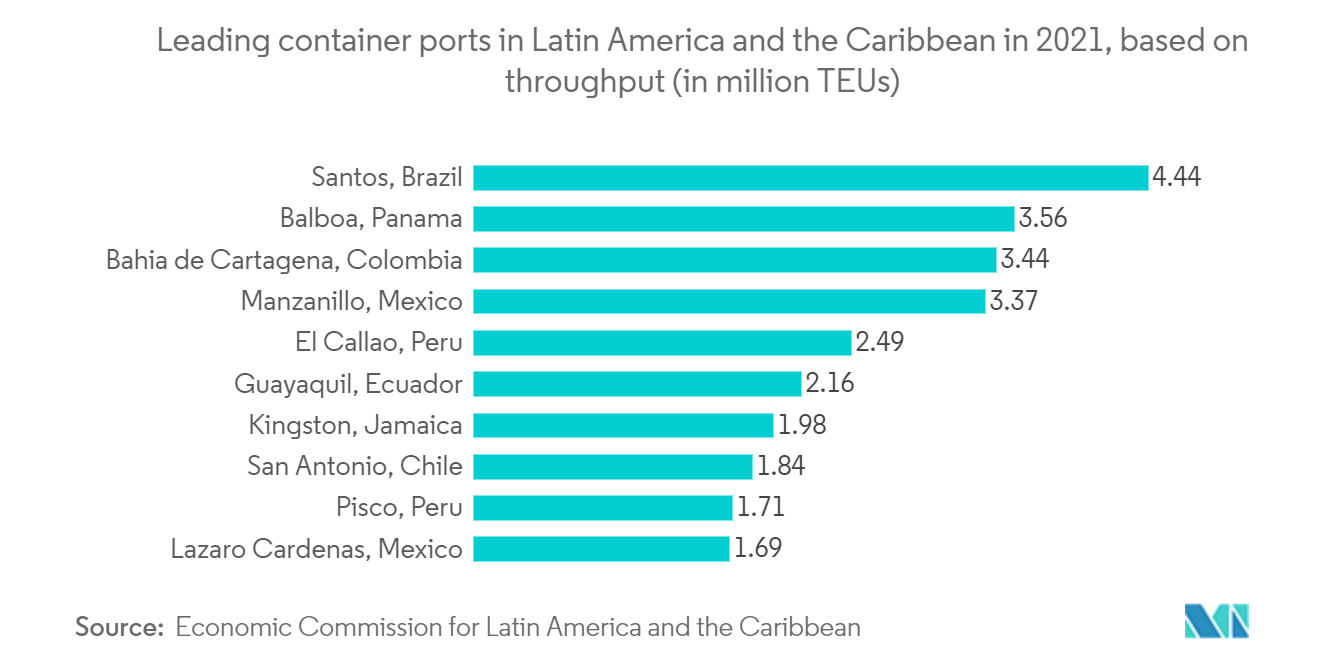Market Trends of Latin America Stevedoring and Marine Cargo Handling Industry
This section covers the major market trends shaping the Latin America Stevedoring & Marine Cargo Handling Market according to our research experts:
Digital transformation and technology adoption is likely to drive the market growth
According to a survey conducted on the Network of Digital and Collaborative Ports, focused on digital transformation and technology adoption. 83% of those surveyed consider Panama, Peru, Mexico, Brazil, and Colombia to be the leading countries in port digital transformation at the regional level, with the ports of Callao, Santos, Manzanillo, Cartagena, and those located in the cities of Colon and Balboa standing out.
The survey provided insight into the perception of ports in Latin America and the Caribbean on the digital transformation of the sector. It showed that the use of innovative technologies such as autonomous vehicles, digital twins, blockchain, virtual reality, artificial intelligence (AI), machine learning, and robotics are used incipiently in the region. Furthermore, the digitalization of seaport business processes may enhance sea-land supply chain performance. Despite numerous benefits, digital transformation in the maritime transport sector lags behind other transport sectors.
Many ports have started implementing digital transformation by standardizing documentation through a Maritime Single Window. Next, introduce a Port Community System and Port Management System, which help optimize, manage, and automate logistics such as vessel traffic, cargo, inspections, permits, and even waste. Thus, the creation of an efficient digital ecosystem would go a long way in streamlining operations and facilitating the exchange of data between shipping lines, port services, cargo handling operations, clearance agencies, and with other transport networks.
Artificial intelligence has many potential applications in the maritime industry, e.g. optimizing business processes, voyage planning, cargo handling, and vessel maintenance. AI-based predictive positioning systems will enable shipmasters and bridge teams to monitor and predict future positions, movements, and maneuvers of their vessel hours in advance, improving situational awareness, decision-making, and ultimately safety. ML/AI technologies are currently able to give an economic effect from the use, optimization, and increase the efficiency of a shipping company. For example, Fuel optimization systems, time optimization in cargo handling, and others.

Increasing Maritime Trade
In 2021, maritime trade in Latin America and the Caribbean (LAC), including both goods loaded and discharged, amounted to 2 billion tons, a 3% increase over 2020. The continent accounted for 12.6% of total goods loaded and 5.8% of total goods discharged.
The COVID-19 pandemic seriously disrupted containerized seaborne trade, exports, and imports in LAC. During the first half of 2020, LAC's containerized trade fell by 12.2%. In the first half of 2022, most LAC subregions increased their containerized cargo exports. However, exports from the Gulf Coast of Mexico remained flat while there were falls in exports from the East Coast of South America (ECSA) and the Pacific coast of Panama.
Between January and June 2022, exports from ECSA, the Pacific coast of Central America, and the Gulf coast of Mexico were lower than in the same period in 2021. In Panama, for the Pacific coast, exports did not recover to 2019 levels, and for the Caribbean coast, there was no recovery in imports.
In the first half of 2022, throughput for regional container ports was mostly similar to 2020. The main exception was the Mexican Pacific coast, which showed greater dynamism. During the pandemic there were more transhipments through the region's large hub ports, so the recent lower dynamism could signal a return to pre-pandemic levels.
As of 1 January 2022, Panama featured among the top three flags of registration in terms of dead-weight tonnage and commercial value. The Bahamas flag had the largest decrease (1.5 percentage points) in dead-weight tonnage. Among the top six registries, ships registered in Panama, followed by China, had the highest average age of the total fleet. Differences in age reflect differences in registry policies, pricing structure, and specialization in different ship types. In January 2022, among these registries, Panama, at 18.9 years, had the highest average age across most ship types except bulk carriers, which represented 58% of its registered fleet. All these activities have been increased at the port. So these factors boost the demand for the stevedoring and marine cargo handling market in Europe during the forecast period.

